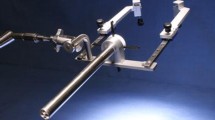Abstract
Background
In laparoscopic surgery, serious complications caused by the blind insertion of trocars are well known. The open technique is compromised by the leakage of carbon dioxide and can also be time consuming, especially in morbidly obese patients. Our aim was to determine whether the optical access trocar can be used to establish a safe and rapid entry during laparoscopic gastric bypass.
Methods
The data on a single surgeon’s experience with 370 laparoscopic gastric bypass procedures during a 4-year period were reviewed. The Optiview trocar was used for all except the initial 21 patients. The entry time for the optical trocar was measured in 10 patients.
Results
Of the 370 patients undergoing laparoscopic gastric bypass from November 2000 to September 2004, the initial 21 were treated using the standard Veress needle to create the pneumoperitoneum. The next 22 were treated using the Veress needle to create the pneumoperitoneum, followed by insertion of the optical access trocar in the left upper quadrant as the initial trocar. From this point to the present, the optical access trocar has been inserted without the use of a Veress needle. There have been no trocar-related bowel or vascular injuries in the entire series. The mean optical trocar insertion time was 28 ± 1.2 s.
Conclusions
This is the first laparoscopic gastric bypass series to report the results of its experience with the optical access trocar. This device provides a safe and rapid technique for placement of the initial trocar for laparoscopic gastric bypass. Insertion of the optical trocar with a 10-mm laparoscope into the left upper quadrant is our procedure of choice for obtaining the pneumoperitoneum in this patient population.






Similar content being viewed by others
References
Bonjer HJ, Hazebroek EJ, Kazemier G, Giufrida MC, Meijer WS, Lange JF (1997) Open versus closed establishment of pneumoperitoneum in laparoscopic surgery. Br J Surg 84: 599–602
Catarci M, Carlini M, Gentileschi P, Santoro E (2001) Major and minor injuries during the creation of pneumoperitoneum: a multicenter study on 12,919 cases. Surg Endosc 15: 566–569
Geers J, Holden C (1996) Major vascular injury as a complication of laparoscopic surgery: a report of three cases and review of the literature. Am Surg 62: 377–379
Hallfeldt KKJ, Trupka A, Kalteis T, Stuetzle H (1999) Safe creation of pneumoperitoneum using an optical trocar. Surg Endosc 13: 306–307
Hashizume M, Sugimachi K, Studygroup of Endoscopic Surgery in Kyushu, Japan (1997) Needle and trocar injury during laparoscopic surgery in Japan. Surg Endosc 11: 1198–1201
Lombezzi R, Galleano R, Lucarini L, Falchero F (2002) New technique for optical control of the first trocar insertion. Minerva Chir 57: 527–529
McKernan JB, Champion JK (1995) Access techniques: Veress needle—initial blind trocar insertion versus open laparoscopy with the Hasson trocar. Endosc Surg Allied Technol 3: 35–38
McKernan JB, Finley CR (2002) Experience with optical trocar in performing laparoscopic procedures. Surg Laparosc Endosc Percutan Tech 12: 96–99
Melzer A, Kipfmuller K, Groenemeyer D, Siebel R, Buess G (1995) Ports, trocars/cannulae, and access techniques. Semin Laparosc Surg 2: 179–204
Melzer A, Riek S, Roth K, Buess G (1995) Endoscopically controlled trocar and cannula insertion. Endosc Surg Allied Technol 3: 63–68
Sharp HT, Dodson MK, Draper ML, Watts DA, Doucette RC, Hurd WW (2002) Complications associated with optical-access laparoscopic trocars. Obstet Gynecol 99: 553–555
String A, Berber E, Foroutani A, Macho JR, Pearl JM, Siperstein AE (2001) Use of the optical access trocar for safe and rapid entry in various laparoscopic procedures. Surg Endosc 15: 570–573
Thomas MA, Rha KH, Ong AM, Pinto PA, Montogomery RA, Kavoussi LR, Jarrett TW (2003) Optical access trocar injuries in urological laparoscopic surgery. J Urol 170: 61–63
Author information
Authors and Affiliations
Corresponding author
Rights and permissions
About this article
Cite this article
Berch, B.R., Torquati, A., Lutfi, R.E. et al. Experience with the optical access trocar for safe and rapid entry in the performance of laparoscopic gastric bypass. Surg Endosc 20, 1238–1241 (2006). https://doi.org/10.1007/s00464-005-0188-4
Received:
Accepted:
Published:
Issue Date:
DOI: https://doi.org/10.1007/s00464-005-0188-4




